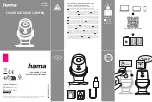
NED
UME-0017-08
SUCL2025T3
15
2.4 Optical Interface
The amount and wavelengths of light required to capture useful images depend on the
intended use. Factors include the property, speed, the object
’s spectral characteristics,
exposure time, the light source characteristics, the specifications of the acquisition
system and so on.
The exposure amount (exposure time x light amount) is the most important factor in
getting desirable images. Please determine the exposure amount after studying what is
most important to your system.
Keep these guidelines in mind when setting up your light source:
LED light sources are relatively inexpensive, provide a uniform field and longer life
span compared to other light sources. However, they also require a camera with
excellent sensitivity.
Halogen light sources generally provide very little blue relative to infrared light (IR).
Fiber-optic light distribution systems generally transmit very little blue light relative
to IR.
Metal halide light sources are very bright but have a shorter life span compared to
other light sources.
Generally speaking, the brighter light sources, the shorter life span.
CCD image sensors are sensitive to infrared (IR). We recommend using daylight color
fluorescent lamps that have low IR emissions. If you use a halogen light source, to
prevent infrared from distorting the images use an IR cutoff filter that does not transmit IR
wavelengths.
















































